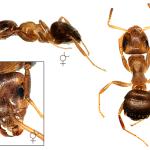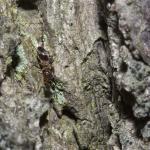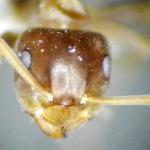Lasius brunneus was first recorded in Britain by Donisthorpe in 1923 (Donisthorpe, 1927). It was not included as a British species in the first edition of Donisthorpe's British Ants (Donisthorpe 1915) and yet, within its current range, it is now locally common and easy to find. Workers of this species look superficially like the common black garden ant L. niger but can be distinguished by, their lighter brownish-red head and alitrunk contrasting with a dark gaster and an absence of standing hairs on the scapes.
Although found in other trees, occasionally in dead wood and even in the timber of buildings, L. brunneus seems to prefer living oak (Quercus sp.) and in particularly large, old trees with some damaged parts. In fact in areas where it is now common, it is hard to find a tree of this type without finding some L. brunneus workers scurrying deep in the crevices of the bark.
The expanding distribution of Lasius brunneus could be explained by a probable introduction to Britain around 1920.
L. brunneus was first recorded in Britain in 1923. It was not included as a British species in the first edition of Donisthorpe's British Ants (Donisthorpe 1915) and yet, within its current range, it is now locally common and often easy to find. It seems likely that this ant was first introduced early in the 20th century and has since spread to much of England and to parts of Wales.
The following sequence of dated distribution maps shows a gradual expansion of range consistent with an initial introduction in Berkshire and gradually spreading to new suitable locations.
The current distribution includes south-east England. The Wye valley, East Anglia and parts of Wales
Overseas, from southern Scandinavia and Russia south to North Africa and Arabia, and east to the Himalayas and Japan.
The species is currently listed as Nationally Notable (Na) (Falk, 1991). This is clearly out of date and based on a much more limited distribution than the one the species currently has.
Most recorded flights have occurred in June or early July and are reported to take place early in the day. Winged gynes and males have been found running excitedly over the bark of infested trees but do not appear to conduct the mass swarming flights of species such as L. niger.
Workers are fugitive and rarely seen away from their host tree or even on its surface. Most activity occurs in bark crevices or tunnels under the bark where the ants tend large tree aphids such as those of the genus Stomaphis. The excreta of these Homoptera forms the majority of their diet, although they may also take other small insects found on or under the bark such as psocids and beetle larvae.
In Britain no parasitic ants are known to be associated with L. brunneus, although the species has been recorded acting as host for temporary social parasitism by L. umbratus queens.
2024




